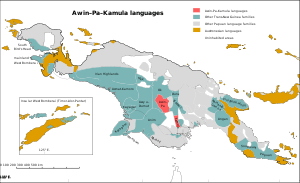Kamula–Elevala languages
The Kamula–Elevala languages are a small family of the Trans–New Guinea languages spoken in the region of the Elevala River.
| Kamula–Elevala | |
|---|---|
| Kamula – Elevala River | |
| Geographic distribution | northern Western Province, Papua New Guinea |
| Linguistic classification | Trans–New Guinea |
| Proto-language | Proto-Kamula–Elevala |
| Subdivisions |
|
| Glottolog | kamu1264[2] |
 Map: The Awin–Pa–Kamula languages of New Guinea
The Awin–Pa and Kamula languages
Other Trans–New Guinea languages
Other Papuan languages
Austronesian languages
Uninhabited | |
Languages
The languages are just three, Aekyowm (Awin), Pare (Pa) and Kamula. They are not obviously related to each other, but Aekyowm and Pare are closer to each other than to Kamula.[3]
- Kamula
- Awin–Pa (Elevala River)
- Aekyowm (Awin)
- Pare (Pa)
Classification
Stephen Wurm (1975) added Awin and Pa to an expanded Central and South New Guinea branch of TNG, a position reversed by Ross (2005). The connection between Awin–Pa and Kamula was established by Suter & Usher.[4]
Reconstruction
| Proto-Kamula–Elevala | |
|---|---|
| Reconstruction of | Kamula–Elevala languages |
Reconstructed ancestors | |
Phonology
Usher (2020) reconstructs the consonant and vowel inventories as follows:[1]
*m *n *p (or *h) *t *s *k *b (or *p) *d *g *s *w *j
*i *u *e *o *ɔ *æ *a
There is also the diphthong *ai.
Pronouns
Usher (2020) reconstructs the Awin–Pa pronouns as:[1]
sg du pl 1 *nɔ *ni, *ki 2 *go *gi 3 *jɔ
In the 1du, Awin has /ki/ and Pare /ni/, /niki/, /nigi/. The Kamula singular forms are quite similar (na, wa, je), but it does not have the dual.
Evolution
Proposed Awin–Pa reflexes of proto-Trans-New Guinea (pTNG) etyma:[5]
Aekyom language:
- kendoke ‘ear’ < *kand(e,i)k[V]
- khatike ‘leg’ < *k(a,o)
- ndok[V], kare ‘skin’ < *(ŋg,k)a(nd,t)apu
- di ‘firewood, fire’ < *inda
- keba ‘head’ < *kV(mb,p)(i,u)tu
- ama ‘mother < *am(a,i)
- di- ‘burn’ < *nj(a,e,i)
References
- Ross, Malcolm (2005). "Pronouns as a preliminary diagnostic for grouping Papuan languages". In Andrew Pawley; Robert Attenborough; Robin Hide; Jack Golson (eds.). Papuan pasts: cultural, linguistic and biological histories of Papuan-speaking peoples. Canberra: Pacific Linguistics. pp. 15–66. ISBN 0858835622. OCLC 67292782.
- New Guinea World, Digul River – Ok
- Hammarström, Harald; Forkel, Robert; Haspelmath, Martin, eds. (2017). "Kamula–Elevala". Glottolog 3.0. Jena, Germany: Max Planck Institute for the Science of Human History.
- Edgar Suter & Timothy Usher, 2017, 'The Kamula–Elevala Language Family', Language & Linguistics in Melanesia, vol. 25.
- Edgar Suter & Timothy Usher (2017) "The Kamula–Elevala language family", Language and Linguistics in Melanesia 35: 106–131.
- Pawley, Andrew; Hammarström, Harald (2018). "The Trans New Guinea family". In Palmer, Bill (ed.). The Languages and Linguistics of the New Guinea Area: A Comprehensive Guide. The World of Linguistics. 4. Berlin: De Gruyter Mouton. pp. 21–196. ISBN 978-3-11-028642-7.
External links
- Timothy Usher, New Guinea World, Proto–Digul River – Ok
- Usher & Suter, Proto–Kamula – Elevala River